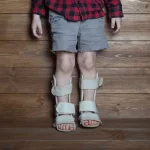Definition and Overview
Cerebral palsy (CP) is a group of disorders that affect a person’s ability to move and maintain balance and posture. It’s caused by damage to the developing brain, most often before birth. CP affects body movement and muscle coordination. It’s not contagious, and it’s not something that will get worse over time, although the symptoms can change as a person ages. The severity of CP can vary widely; some people might have mild difficulties, while others may be more severely affected.
Types of Cerebral Palsy
There are several different types of cerebral palsy, classified based on the type of movement disorder involved:
- Spastic Cerebral Palsy: This is the most common type, characterized by stiff muscles and exaggerated reflexes. It can affect one side of the body (hemiplegia), both legs (diplegia), or all four limbs (quadriplegia).
- Dyskinetic Cerebral Palsy: This type involves involuntary movements, which can be slow and writhing (athetosis) or rapid and jerky (chorea). Muscle tone can vary from too tight to too loose.
- Ataxic Cerebral Palsy: This affects balance and coordination. People with ataxic CP may have difficulty with walking, writing, and other fine motor skills. Congenital neuromuscular disorder is a term that describes this condition.
- Mixed Cerebral Palsy: Some people have symptoms of more than one type of CP. The most common mixed type is spastic-dyskinetic.
Causes and Risk Factors
CP is caused by abnormal brain development or damage to the brain. This can happen before, during, or shortly after birth. Sometimes, the exact cause isn’t known. However, several factors can increase the risk of CP:
- Premature birth: Babies born prematurely are at a higher risk of CP.
- Low birth weight: Babies who weigh less than 5.5 pounds at birth are also at increased risk.
- Infections during pregnancy: Certain infections, like rubella or cytomegalovirus (CMV), can increase the risk of CP.
- Brain injuries: Injuries to the baby’s brain during birth or in early infancy can cause CP. Range of disorders can be caused by these injuries.
- Multiple births: Twins, triplets, and other multiple births have a higher risk of CP than single births.
Symptoms and Diagnosis
Common Symptoms of Cerebral Palsy
Okay, so cerebral palsy? It’s different for everyone. You might see some kids who are just a little bit clumsy, while others have a really tough time moving around. The symptoms can really vary, and it depends on the type and how severe it is. Some things to look out for:
- Muscle tone issues: This could be stiffness (spasticity) or floppiness. It’s not always consistent, either.
- Delays in reaching milestones: Like sitting up, crawling, or walking. If a kid isn’t hitting those marks when they should, it’s something to check out. mobility aids can help with movement.
- Difficulty with coordination and balance: They might seem unsteady or have trouble with tasks that require fine motor skills, like writing or buttoning a shirt.
- Involuntary movements: Some people with CP have movements they can’t control, like tremors or jerky motions.
Diagnostic Procedures
Getting a diagnosis usually involves a few steps. First, the doctor will do a physical exam and check the kid’s motor skills, muscle tone, and reflexes. They’ll also ask about the child’s development and medical history. Then, they might order some tests to rule out other conditions and get a clearer picture of what’s going on. These tests could include:
- MRI (Magnetic Resonance Imaging): This gives a detailed look at the brain. It can help spot any abnormalities or damage.
- CT scan (Computed Tomography): Another imaging test, but it’s not as detailed as an MRI. Still, it can be useful.
- EEG (Electroencephalogram): This measures brain activity. It’s used to check for seizures, which can sometimes be associated with CP.
- Genetic testing: In some cases, genetic factors can play a role, so testing might be done to look for specific genetic conditions. It’s a process, but it’s all about getting the right diagnosis so the kid can get the support they need. motor difficulties can impact daily activities.
Differential Diagnosis
So, when doctors are trying to figure out if a kid has cerebral palsy, they also have to rule out other things that could be causing similar symptoms. It’s like a process of elimination. Some conditions they might consider include:
- Genetic disorders: There are lots of genetic conditions that can affect motor skills and development, like muscular dystrophy or spinal muscular atrophy.
- Metabolic disorders: These are conditions that mess with the body’s ability to process certain substances. Some of them can cause neurological problems.
- Brain tumors: Although rare, brain tumors can sometimes cause symptoms that look like CP.
- Neuromuscular disorders: These affect the nerves and muscles. There are a bunch of different ones, and they can all have different symptoms. The key is to look at the whole picture – the symptoms, the test results, and the kid’s medical history – to make the right call.
Treatment Options and Therapies
Physical Therapy
Physical therapy is super important for people with cerebral palsy. It’s all about improving motor skills, strength, and flexibility. The main goal is to help individuals move better and be more independent. Therapists use different exercises and techniques to work on things like posture, balance, and coordination.
Here are some common things they do:
- Stretching exercises to increase range of motion
- Strengthening exercises to build muscle
- Gait training to improve walking
- Early intervention is key to maximizing the benefits of physical therapy.
Occupational Therapy
Occupational therapy focuses on helping people perform everyday tasks. This can include things like dressing, eating, and writing. The goal is to help individuals participate more fully in daily life. Occupational therapists work with people to develop the skills they need to be as independent as possible. They might suggest adaptive equipment or modifications to the home or school environment to make things easier.
Some areas they focus on are:
- Fine motor skills, like buttoning a shirt
- Self-care activities, like brushing teeth
- Cerebral palsy treatment often includes strategies for adapting to the environment.
- Sensory integration to help manage sensory sensitivities
Medications and Surgical Interventions
Medications can help manage some of the symptoms of cerebral palsy, like spasticity (muscle stiffness) and seizures. Common medications include muscle relaxants and anti-seizure drugs. Surgery might be an option in some cases to correct deformities or improve muscle function. For example, selective dorsal rhizotomy is a surgical procedure that can reduce spasticity in the legs. It’s a big decision, and it’s important to talk to your doctor about the risks and benefits. Medication and surgery are usually considered when other therapies aren’t enough. It’s not a one-size-fits-all thing, and what works for one person might not work for another.
Here are some examples:
- Botulinum toxin (Botox) injections to relax specific muscles
- Baclofen pumps to deliver medication directly to the spinal cord
- Orthopedic surgeries to correct bone or joint problems
Impact on Daily Life
Challenges in Mobility
For individuals with cerebral palsy, daily life often presents unique physical hurdles. Mobility can be significantly affected, and it’s something many families learn to adapt to. The degree of impact varies widely, depending on the type and severity of the CP. Some people might experience mild stiffness, while others face more significant limitations. These challenges can include:
- Difficulty with walking or maintaining balance. Muscle tone can be a big factor here.
- Reliance on assistive devices like wheelchairs, walkers, or braces. These tools can really help maintain independence.
- Increased risk of falls and injuries. Safety is always a top priority.
Communication Difficulties
Communication is another area that can be impacted. It’s not just about speaking; it involves understanding and expressing thoughts and feelings. Some individuals with CP may have difficulties with:
- Speech production, including articulation and fluency. This can make it hard for others to understand them.
- Language comprehension, affecting their ability to understand what others are saying.
- Nonverbal communication, such as facial expressions and gestures. Sometimes, alternative methods are needed.
Assistive communication devices, like speech-generating devices, can be incredibly helpful. Speech therapy is also a common and effective intervention.
Social and Emotional Effects
Living with cerebral palsy can also have social and emotional implications. It’s important to remember that everyone’s experience is different, but some common challenges include:
- Feelings of isolation or exclusion. It’s important to build strong support networks.
- Difficulties with self-esteem and confidence. Positive reinforcement and encouragement are key.
- Increased risk of anxiety and depression. Therapeutic interventions can make a big difference.
It’s crucial to address these emotional needs through counseling, therapy, and supportive relationships. Building a strong sense of self-worth and belonging is essential for overall well-being.
Support and Resources
Educational Support Services
Navigating the educational system can be tough for families of kids with cerebral palsy. It’s not always clear what’s available or how to get it. The good news is that there are services designed to help. These might include things like individualized education programs (IEPs), which tailor learning to a child’s specific needs. Schools also sometimes offer assistive technology, like special software or equipment, to help with learning. Don’t be afraid to ask questions and advocate for your child’s needs. It can make a big difference. The Weinberg Family Cerebral Palsy Center can be a great place to start.
Community Resources
Beyond the classroom, there are tons of community resources that can provide support. Think about local support groups where you can connect with other families facing similar challenges. These groups can be a lifeline for sharing experiences and getting advice. There are also recreational programs adapted for individuals with disabilities, offering opportunities for fun and social interaction. Don’t forget about respite care services, which give caregivers a much-needed break. Here are some things to consider:
- Local disability organizations
- Recreational programs
- Respite care services
Advocacy Organizations
Sometimes, you need someone in your corner to fight for your rights and access to services. That’s where advocacy organizations come in. These groups work to raise awareness about cerebral palsy and advocate for policies that support individuals with disabilities. They can also provide legal assistance and guidance on navigating complex systems. These organizations can be a powerful voice for change. Check out United Cerebral Palsy for more information. Here are some things they can help with:
- Legal assistance
- Policy changes
- Raising awareness
Research and Future Directions
Current Research Trends
Research into cerebral palsy is constantly evolving, with scientists and medical professionals working to improve understanding and treatment of the condition. A big area of focus is early detection. Researchers are exploring new ways to identify cerebral palsy in infants as early as possible, because the earlier the intervention, the better the potential outcomes. Recent studies highlight the effectiveness of computer vision and deep learning techniques in analyzing infant movements, which are essential for early detection of developmental issues.
Another trend is the development of more targeted therapies. Instead of a one-size-fits-all approach, researchers are trying to create treatments that are tailored to the specific needs of each individual with cerebral palsy. This includes:
- Genetic research to understand the underlying causes of cerebral palsy.
- Studies on the effectiveness of different types of therapies.
- Development of new assistive technologies.
Innovative Therapies
Several innovative therapies are on the horizon for cerebral palsy. One promising area is the use of robotics to help improve movement and coordination. Robotic devices can provide support and assistance during therapy sessions, allowing individuals to practice movements that they might not be able to do on their own. Another area of interest is gene therapy, which could potentially correct the underlying genetic defects that cause some cases of cerebral palsy. Brain-computer interfaces are also being explored as a way to bypass damaged areas of the brain and allow individuals to control assistive devices with their thoughts.
Other innovative approaches include:
- Virtual reality therapy to create immersive and engaging treatment environments.
- Stem cell therapy to repair damaged brain tissue.
- Advanced imaging techniques to better understand brain function.
Future Outlook for Treatment
The future of cerebral palsy treatment looks promising. With ongoing research and the development of new therapies, it is hoped that individuals with cerebral palsy will have access to more effective treatments that can improve their quality of life. Future directions in MHDT technology for CP management present numerous research opportunities, emphasizing advanced data integration and innovative approaches to enhance patient care and outcomes. The focus is on:
- Developing more personalized treatment plans.
- Improving early detection and intervention.
- Finding ways to prevent cerebral palsy from occurring in the first place.
Ultimately, the goal is to help individuals with cerebral palsy live full and independent lives.
Living with Cerebral Palsy
Personal Stories and Experiences
It’s really important to hear directly from people who are living with cerebral palsy. Their stories can show the wide range of experiences and challenges, but also the triumphs. These personal accounts can offer hope and understanding to others facing similar situations. You might read about someone who uses assistive technology to communicate, or another person who participates in adaptive sports. These stories highlight resilience and the ability to live a full life, despite the obstacles. Check out this series showcasing individuals living with cerebral palsy, emphasizing the diversity and complexity of their experiences.
Coping Strategies for Families
Having a child with cerebral palsy affects the whole family. It’s not always easy, and families need to find ways to cope with the unique demands. Some helpful strategies include:
- Seeking professional counseling or therapy to manage stress and emotions.
- Establishing a consistent routine to provide structure and predictability for the child.
- Learning about cerebral palsy and available resources to make informed decisions.
- Practicing self-care to maintain physical and mental well-being.
- Joining a support group to connect with other families facing similar challenges.
It’s also important for families to celebrate small victories and focus on the child’s strengths and abilities. Remember that it’s okay to ask for help and to take breaks when needed. Children with cerebral palsy face a significantly higher risk of depression, being up to five times more likely to experience it compared to their nondisabled peers.
Building a Support Network
A strong support network can make a huge difference in the lives of people with cerebral palsy and their families. This network can include:
- Family members and friends who offer emotional support and practical assistance.
- Healthcare professionals, such as doctors, therapists, and nurses, who provide medical care and guidance.
- Educators and school staff who create an inclusive learning environment.
- Community organizations and advocacy groups that offer resources and support services.
- Online forums and social media groups where people can connect with others who understand their experiences.
Building a support network takes time and effort, but it’s worth it. Having people to turn to for help and encouragement can make the journey much easier. Don’t be afraid to reach out and connect with others who can offer support and understanding.




















